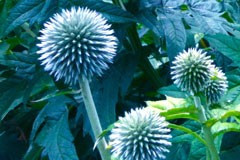
Achillea ptarmica 'The Pearl'
White double flowers. Strongly clumping variety useful as a cut flower or cottage garden background infill perennial; easy and prolific. Stake in windy areas or cram in between miscanthus and eupatorium.


Reputedly more blue than others, we find these echinops, contrary to their appearance, are best situated in a cooler position with only part day sun. To yield their best, plant in fertile drained soil and a sheltered position.
Reputedly more blue than others, we find these echinops, contrary to their appearance, are best situated in a cooler position with only part day sun. To yield their best, plant in fertile drained soil and a sheltered position.
Data sheet
White double flowers. Strongly clumping variety useful as a cut flower or cottage garden background infill perennial; easy and prolific. Stake in windy areas or cram in between miscanthus and eupatorium.
Low growing sedum with cascading habit, ideal for bank or over wall. Rose pink to ruby flowers in summer.
Our own variety which we have multiplied from division, flame orange fading into chesnut brown.
Select large flowered form of the species, vigorous and long flowering. Medium height bushy plant, earlier than asters but works to same effect amongst other perennials.
The lovely and hardy winter flowering iris from Greece with lavender flowers during winter. Survives well in dry summer areas.
Native of North America growing on forest margins, forming good spreading groundcover. Evergreen foliage and cream bells, extremely cold hardy.
Robust and moisture tolerant species from Nepal, with attractive tall foliage and lime-green flowers. A stately elegant plant that can be cut to the ground in winter, flowers appear early summer alongside delphiniums, lupins, and campanula.
New variety from our trial beds, a lovely pink form which is an offspring from Achillea 'Love Parade', demonstates all the rubustness of other achillea varieties. Once established best not overly fertilized to maintain upright habit, as with other varieties.
Low growing silvery grey foliage variety which is evergreen in mild climates, long lived and drought hardy, useful in mediterranean gardens with gaura, rosmary and wallflowers.
Low growing variety with pink tinged foliage, bee attracting summer flowering.
A compact species for border and rock garden which works well for ground cover and edging, does not collapse like taller varieties. Very drought tolerant and tidy compact growth.
The best red monarda; mildew resistant and tough as they come. Like all monarda, these grow best on fertile clay loam or well mulched moisture retentive soil types.
Double white form, sweetly fragrant and lovely. Easy and clumping like other forms, best used in shade as ground cover.
White flowers suffused with the palest lilac, darkest at the tips. Tall stems great for flower arranging. Amongst my current favourites.
The best red cultivar with a hint of black spotting in the centre of the flower. Tall erect flower stems. Avoid growing oriental poppies in pots, plant in ground directly.
A wonderful variety with large white flowers like Romneya coulteri, unfortunately difficult to propagate so only a few.

Reputedly more blue than others, we find these echinops, contrary to their appearance, are best situated in a cooler position with only part day sun. To yield their best, plant in fertile drained soil and a sheltered position.